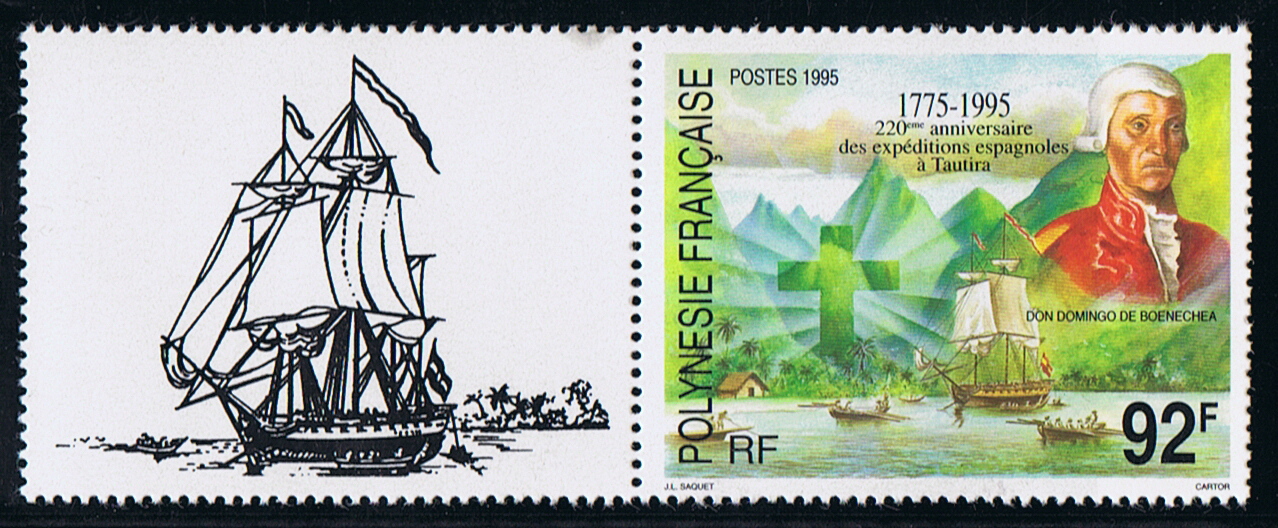
I don't have many details on the ship herself, but some other information from some web sites on the voyages is also interesting.
The AGUILA a frigate was used by Don Domingo de Boenechea (or Bonechea) (ca 1711-1775) for the first voyage to establish a Spanish colony on Tahiti, which the Spanish named Amat, named after the viceroy of Chile and Peru, Don Manuel de Amat.
Set sail on 26 September 1772 from Callao, Peru for his first voyage.
Bonechea discovered an island, which he named San Simon y Judas, what is now known as Tauere in the Tuamotu Archipelago, and an other island what he named San Quintin (Haraiki). Two other islands discovered were Anaa and Meetia before the AGUILA arrived at Tahiti.
The island Moorea he named Santo Domingo.
He anchored in the waters off Tautira (ESE from Tahiti) from 9 Nov until 20 Dec. 1772. He returned at Callao on March 1773.
The second expedition to Tahiti commenced when he sailed with two vessels on 20 Sept. 1774 from Callao, the AGUILA under his command and a store ship the JUPITER under command of Don Thomas Gayanos.
On this voyage he took two Franciscan missionaries with hem.
During the voyage the islands San Narciso (Takatoko) was discovered, and Tauere sighted. Other islands sighted or visited this voyage were Los Martires (Tekokoto, San Juan (Hikueru), Haraiki, Anaa, Meetia before arriving at Tahiti.
In a bay in the Tautira-District, named by the Spanish, Santa Cruz de Ohatutira a good place was found to build a house for the priests.
Then the two ship set sail for Orayatea (Raiatea), and on his return from Raiatea in Tautira, Boenechea got seriously ill and died in Tahiti on 26 January 1775.
Command was taken over by Thomas Gayangos and the two ships sailed to Callao, where she arrived on 8 April 1775.
By French Polynesia a stamp was issued on 1 Jan. 1995 to commemorate the first expedition 220 years ago.
It depict the AGUILA on arrival, (the stamp shows a ship of that time, a painting or picture of the ship does not exist.) The coast and first mountain peaks of Tautira are in the background of the stamp.
The stamp depicts a portrait of Don Domingo de Boenechea, and a cross.
Boenechea was buried on the foot of the cross, which was placed in front of the poorhouse, which was built to meet the needs of the poor in the missionary settlement.
The AGUILA made an other voyage to the new colony in 1775, when she sailed under command of Don Cayetano de Langara with stores and supplies for the missionaries at Tahiti. But both missionaries Pater Geronimo Clota and Pater Narciso Gonzales wanted to return home, they were afraid for their personal security on the island. The AGUILA returned at Callao on 16 Feb. 1776 with the missionaries.
The records of the two priests are saved and give interesting and ethnologic details of the island and people.
Fate of the AGUILA till so far not know.
French Polynesia 1995 92Fr. sg 716, scott 653
http://www.univie.ac.at/Voelkerkunde/ap ... nechea.htm in German .
http://www.tahiti-postoffice.com/englis ... 8-1/2.html
http://www.paisvasco.com/getaria/english/sons.htm
http://www.univie.ac.at/Voelkerkunde/ap ... angara.htm in German.
